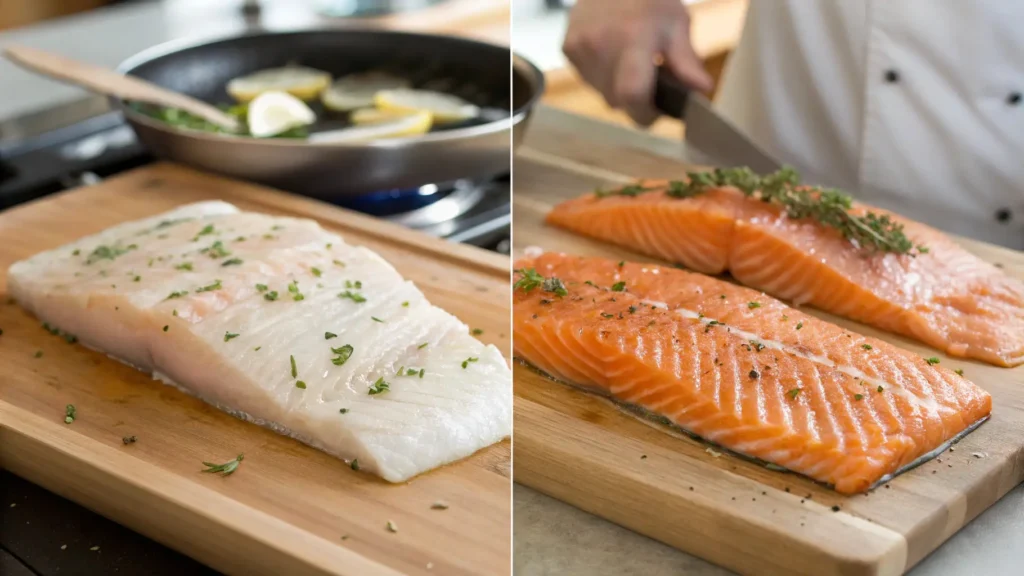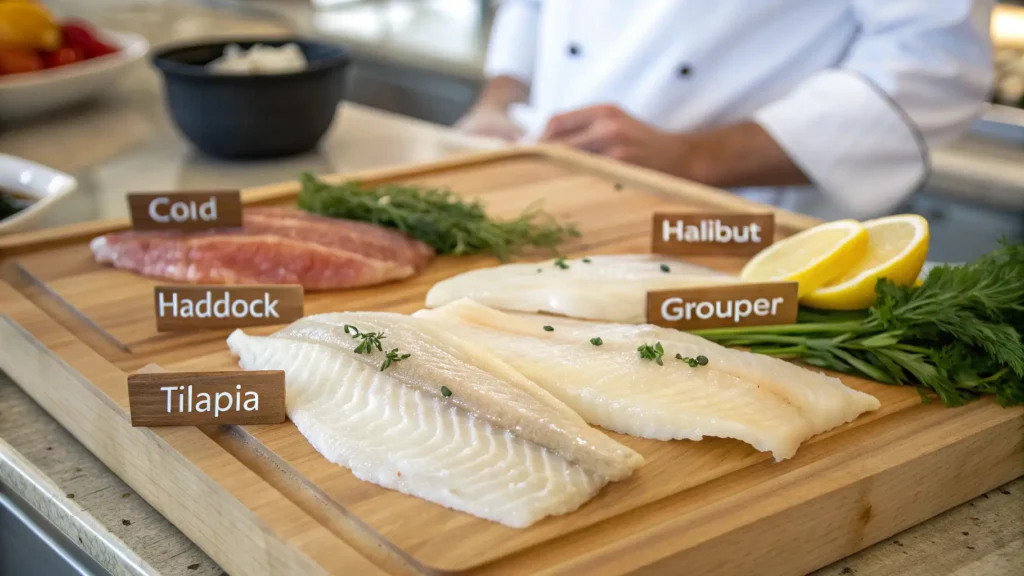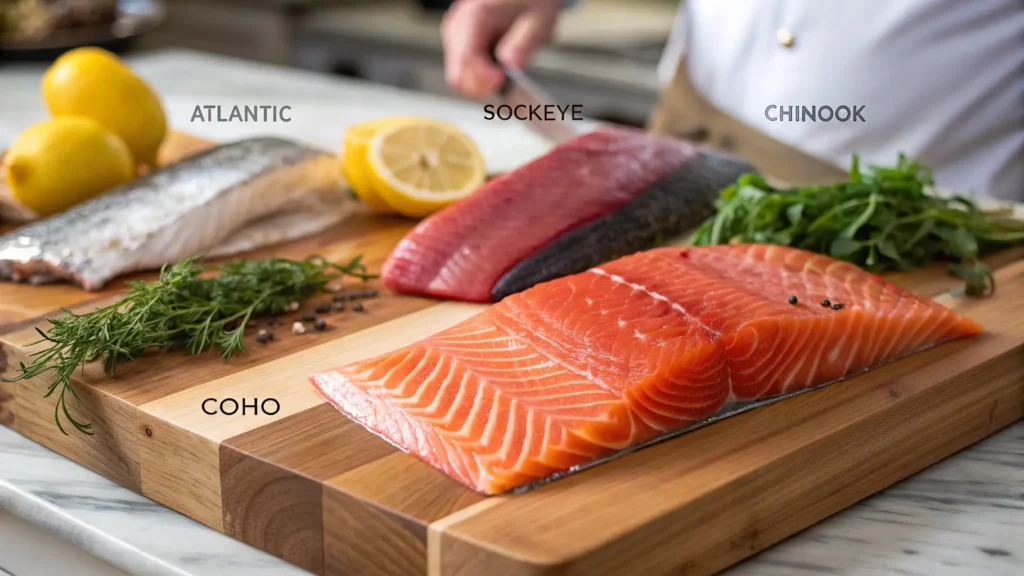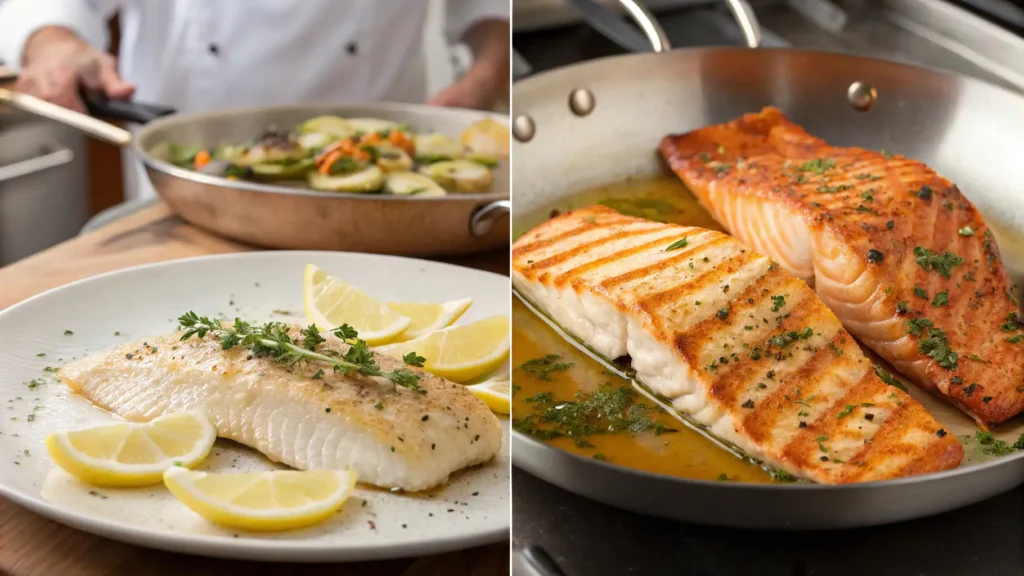When it comes to seafood, whitefish and salmon often take center stage on menus and dinner plates. But is whitefish a salmon? Despite their occasional similarities, these two fish belong to different categories, offering unique characteristics, flavors, and nutritional benefits.

This article breaks down the key differences between whitefish and salmon, helping you understand their unique qualities, how they compare, and which one might be best suited for your meals. Whether you’re looking for a light, lean option or a rich, flavorful catch, we’ll guide you through everything you need to know.
What Is Whitefish?
Whitefish refers to a category of fish characterized by their lean, pale-colored flesh and mild flavor. Unlike oily fish, whitefish store most of their fat in their liver rather than their flesh, making them a low-fat, high-protein option.
Examples of Common Whitefish
Whitefish includes a variety of species found in both freshwater and saltwater environments. Some popular examples are:

- Cod: A widely available and adaptable fish with a firm yet flaky texture and a neutral, slightly sweet taste. Cod is a favorite for fish and chips, baking, and broiling, as it easily absorbs flavors from seasonings and sauces.
- Haddock: Slightly sweeter than cod, haddock has a delicate yet firm texture, making it ideal for smoking, chowders, and frying. It’s commonly used in New England seafood dishes and works well in battered or breadcrumb-coated recipes.
- Tilapia: A lean, freshwater fish with a firm texture and mild taste, tilapia is highly versatile and pairs well with bold seasonings and marinades. It’s commonly grilled, pan-seared, or fried, making it a favorite for easy weeknight meals.
- Halibut: Known for its dense, meaty texture, halibut holds up well to various cooking methods. It’s excellent for roasting, grilling, and pan-searing, often paired with buttery or citrus-based sauces to enhance its naturally mild flavor.
- Sole: A delicate flatfish with a light, almost sweet taste, sole is best prepared pan-fried, lightly battered, or served with gentle sauces like lemon butter. Its thin fillets cook quickly, making it a great choice for fast, elegant meals.
Whitefish is prized for its subtle flavor, which makes it a versatile ingredient in various recipes.
What Is Salmon?
Salmon, unlike whitefish, is classified as an oily fish, meaning it has higher fat content distributed throughout its flesh. This fat gives salmon its rich flavor and buttery texture, as well as its vibrant pink or orange color.
Popular Salmon Species
There are several species of salmon, including:

- Atlantic Salmon: The most commonly farmed variety, known for its mild, buttery flavor and tender flesh. Due to its availability, it is a popular choice for baking, broiling, and pan-searing.
- Chinook (King) Salmon: Often considered the finest and most luxurious salmon, King salmon has a high fat content, giving it a rich, melt-in-your-mouth texture. Its deep flavor makes it perfect for grilling, roasting, and gourmet preparations.
- Sockeye Salmon: Recognizable by its deep red flesh, Sockeye has a robust, slightly stronger flavor than other varieties. It is excellent for roasting, broiling, and smoking, as its firm texture holds up well to different cooking methods.
- Coho Salmon: A leaner option with a milder taste, Coho is ideal for those who prefer a lighter salmon flavor. Its firm but not overly fatty flesh makes it perfect for grilling, smoking, or pan-searing.
Salmon’s nutritional profile and bold flavor make it a popular choice for health-conscious eaters and gourmet dishes.
Key Differences Between Whitefish and Salmon
Whitefish and salmon differ in several key aspects, from their physical characteristics to their nutritional profiles and culinary uses. Here’s a breakdown to help answer is whitefish a salmon:
1. Appearance
- Whitefish: The flesh of whitefish is pale, ranging from white to off-white. These fish are often smaller, with thinner fillets that cook quickly. Examples include tilapia, cod, and sole.
- Salmon: Salmon’s flesh is typically pink to reddish-orange due to its diet, which includes carotenoid-rich krill. Salmon fillets are thicker, with a firmer texture that holds up well to grilling and roasting.
2. Flavor Profile
- Whitefish: Whitefish has a mild, neutral flavor that makes it a great canvas for various seasonings and sauces. It’s ideal for those who prefer delicate-tasting seafood.
- Salmon: Salmon offers a rich, buttery taste with a hint of sweetness. Its bold flavor is distinctive and pairs well with savory or tangy ingredients.
3. Fat Content and Nutrition
- Whitefish: Low in fat and calories, whitefish is an excellent source of lean protein. A typical 3-ounce serving contains less than 2 grams of fat and approximately 20 grams of protein. It’s also rich in vitamins B12 and D, as well as minerals like selenium.
- Salmon: As an oily fish, salmon is higher in fat, particularly heart-healthy omega-3 fatty acids. A 3-ounce serving contains around 10–13 grams of fat and 22–25 grams of protein, along with substantial amounts of vitamin D and potassium.
4. Habitat
- Whitefish: Found in both freshwater (e.g., tilapia, perch) and saltwater (e.g., cod, haddock), whitefish adapt to a variety of environments.
- Salmon: Primarily found in cold waters, salmon is an anadromous fish, meaning it migrates between freshwater and saltwater during its life cycle.
Cooking and Culinary Uses

How Whitefish Is Used
Whitefish’s delicate texture and mild flavor make it incredibly versatile, allowing it to blend seamlessly with various seasonings and sauces. It is commonly prepared using these methods:
Baking: Light, flaky fish such as tilapia or cod are baked with lemon, garlic, and herbs, creating a simple yet flavorful dish.
Pan-Frying: Sole fillets are lightly breaded and fried, then paired with a buttery or lemon-based sauce for a crisp yet tender bite.
Steaming: Halibut is gently steamed with ginger and soy, resulting in a light, healthy, and aromatic meal.
Poaching: Whitefish like haddock or halibut can be poached in broth or wine, keeping the flesh moist and delicate while enhancing its subtle taste.
💡 Best For: Those who enjoy lighter, milder seafood that pairs well with various sauces and seasonings.
How Salmon Is Used
Salmon’s rich, firm texture makes it ideal for bolder preparations that enhance its deep flavor. Some of the most popular methods include:
Grilling: Coho or Chinook salmon is grilled with a smoky marinade, creating a charred exterior and juicy, flavorful inside.
Roasting: Sockeye salmon is roasted with a honey and Dijon mustard glaze, balancing its robust taste with a sweet-savory coating.
Smoking: Thin slices of smoked salmon are commonly used in bagels, salads, and appetizers, offering a savory, slightly salty bite.
Pan-Searing: A simple pan-seared fillet with crispy skin enhances salmon’s natural richness, making it a favorite for quick yet elegant meals.
💡 Best For: Those who prefer a heartier, bolder seafood option that stands up to marinades, glazes, and robust seasonings.
Both whitefish and salmon bring unique qualities to the table, allowing home cooks and chefs alike to experiment with different flavors and techniques for delicious seafood dishes.
Key Takeaway
While both whitefish and salmon are versatile, whitefish is ideal for subtle dishes, while salmon’s bold flavor allows it to stand out in recipes with stronger ingredients.
Which Should You Choose?
Deciding between whitefish and salmon depends on your taste preferences, dietary goals, and the type of meal you’re preparing. Here’s how to determine the best choice for your needs:
1. For Flavor
- Choose whitefish if you prefer a mild, neutral taste that easily takes on the flavors of seasonings and sauces. It’s great for dishes like baked tilapia, fish tacos, or delicate poached recipes.
- Opt for salmon if you enjoy a richer, more pronounced flavor with a buttery texture. Salmon pairs well with bold marinades, citrusy glazes, or smoky grilling techniques.
2. For Nutrition
- Go with whitefish for a leaner, lower-calorie option that’s still packed with protein. It’s perfect for those focusing on weight loss or maintaining a low-fat diet.
- Choose salmon if you’re looking for a heart-healthy option rich in omega-3 fatty acids and vitamin D. Salmon is ideal for supporting brain function, reducing inflammation, and promoting cardiovascular health.
3. For Cooking Versatility
- Whitefish is a versatile choice for light dishes that won’t overpower other ingredients. Use it in recipes like steamed cod with vegetables or lightly fried sole.
- Salmon is more robust, making it ideal for grilling, smoking, or roasting. It holds up well to bolder flavors and heavier accompaniments like creamy sauces or roasted root vegetables.
4. For Sustainability
Both whitefish and salmon can be sustainable options, but it depends on the species and source:
- Look for sustainably farmed tilapia, cod, or haddock with certifications like MSC (Marine Stewardship Council).
- For salmon, choose wild-caught varieties like Alaskan salmon, which are often more eco-friendly than farmed alternatives.
Conclusion
So, is whitefish a salmon? The answer is no—whitefish and salmon are entirely different categories of fish. Whitefish refers to lean, mild-flavored species like cod, haddock, and tilapia, while salmon is an oily fish known for its rich flavor, high omega-3 content, and vibrant color.
Both offer unique benefits and culinary possibilities, so the best choice depends on your personal taste, nutritional needs, and recipe preferences. Whitefish is ideal for light, delicate meals, while salmon shines in bold, flavorful dishes.
If you’re looking for inspiration, pair whitefish with a refreshing side like this Apple Spice Cake or try salmon with a hearty option like this Marry Me Chicken Soup Recipe.
Explore both options in your cooking and enjoy the versatility and health benefits they bring to your table!
